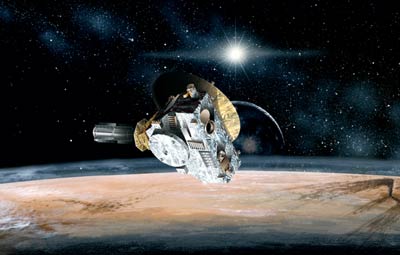A historic space mission nears launchby S. Alan Stern
|
| New Horizons represents almost 17 years of work by the scientific community to finally complete the reconnaissance of our planetary system. |
New Horizons (see pluto.jhuapl.edu for more information) will travel over six billion kilometers to explore Pluto and the Kuiper Belt for the first time. The mission was selected by NASA in 2001 after an intense competition that ranked New Horizons as “lowest cost, greatest scientific return” proposal it received to explore Pluto and the Kuiper Belt. Designed, built, and tested in just over four years, New Horizons is the first of a new class of lower-cost robotic missions to the outer planets costing just dimes on the dollar compared to more recent outer planets exploration.
And yet, despite its lower cost, the New Horizons spacecraft is technologically amazing. It is no larger than a piano and weighs less than 500 kilograms, including eight sophisticated scientific sensors, maneuvering fuel, and packs within its structure all of the radios, computers, propulsion equipment, and power distribution equipment needed to make possible its historic crossing of the solar system and its exploration of Pluto and farther worlds in the Kuiper Belt. In fact, New Horizons carries not one but two copies of most of its electronics in order to bring along spares for the long journey.
When launched on its Atlas 5 rocket in January, New Horizons will be the fastest spacecraft ever to leave Earth, and that speed is crucial. New Horizons will cross the orbit of the Moon in just nine hours—something that took Apollo spacecraft over three days to accomplish after their launch to a speed of 40,000 kilometers per hour. New Horizons will then journey to Jupiter for a gravitational slingshot to further speed the journey to Pluto. Whereas the two most recent missions NASA sent to Jupiter—Galileo and Cassini—took six and four years, respectively, the much faster New Horizons spacecraft will make its trip to Jupiter in just 13 months.
Although Jupiter is almost a billion kilometers away, it is only a small fraction of the distance to Pluto. So, after exploring the Jupiter system in early 2007 and gaining a speed boost from its gravity, New Horizons will set out across the great, five-billion-kilometer gulf of our outer solar system toward Pluto. Traveling nearly 100 times the average speed of a jetliner, 24/7, it will reach Pluto in 2015 for a five-month long set of intensive explorations. New Horizons will then go on to explore smaller worlds in the Kuiper Belt in the years that follow.
Great nations do great things, and one of the lasting historical legacies of our nation, the United States, is that we led the exploration of the planets. From Mercury to Neptune, the flag of the United States was always first. New Horizons plans to make this the case with Pluto as well. In doing so, we hope to expand the knowledge we have of our home solar system, inspire a new generation of scientists and engineers to tackle even tougher challenges, and provide the people of other nations with a good example of our country’s spirit, leadership, and capability for peaceful scientific exploration. So too, New Horizons will stand for all time as a record of something visionary that we 21st century Americans were doing in our time.
